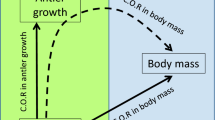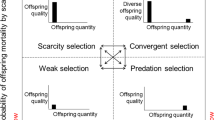Abstract
The culling of kangaroos at the Puckapunyal Army base (Australia) raises some intriguing ethical issues around animal welfare. After discussing the costs and benefits of the cull, this paper addresses the more general animal welfare issues related to population dynamics. Natural selection favours the maximization of the number of surviving offspring. This need not result in the maximization of the welfare of individuals in the species. The contrast between growth maximization and welfare maximization is first illustrated for a single population and then discussed in terms of competing populations. In the Lotka-Volterra model of competing species and its generalizations, the choice of different birthrates does not affect the population sizes at equilibrium. Welfare could be much higher at lower birthrates without even reducing numbers (at equilibrium).
Similar content being viewed by others
References
Abrams PA (1991) The effects of interacting species on predator-prey coevolution. Theor Popul Biol 39:241–262
Bernstein C, Kacelnik A, Krebs JR (1988) Individual decisions and the distribution of predators in a patchy environment. J Anim Ecol 57:1007–1026
Blackorby C, Donaldson D (1984) Social criteria for evaluating population change. J Public Econ 25(1–2):13–34
Blackorby C, Donaldson D (1992) Pigs and guinea pigs: a note on the ethics of animal exploitation. Econ J 102(415):1345–69
Broome J (2001) Measuring the burden of disease by aggregating well-being. In: Murray C., Salomon J., Mathers C., Lopez A. (eds) Summary measures of population health: concepts, ethics, measurement and applications. World Health Organization, Geneva
Chesson PL (1985) Coexistence of competitors in spatially and temporally varying environments: a look at the combined effects of different sorts of variability. Theor Popul Biol 28:263–287
Cohen D, Levin SA (1991) Dispersal in patchy environments: the effects of temporal and spatial structure. Theor Popul Biol 39:63–99
Connell JH (1983) On the prevalence and relative importance of interspecific competition: Evidence from field experiments. Am Nat 122:661–696
Cressman R, Garay J (2003) Evolutionary stability in Lotka-Volterra systems. J Theor Biol 222:233–245
Darwen PJ, Green DG (1996) Viability of populations in a landscape. Ecol Model 85(2–3):165–171
Demetrius U (1992) Growth rate, population entropy, and evolutionary dynamics. Theor Popul Biol 41:208–236
Derrick W, Metzgar L (1991) Dynamics of Lotka-Volterra systems with exploitation. J Theor Biol 153:455–468
Edmunds J, Cushing JM, Costantino RF, Henson SM, Dennis B, Desharnais RA (2003) Park’s Tribolium competition experiments: a non-equilibrium species coexistence hypothesis. J Anim Ecol 72:703–712
Gillespie JH (1998) Population genetics: a concise guide. The Johns Hopkins University Press, Baltimore, MD
Gordon CE (2000) The coexistence of species. Rev Chil Hist Nat 73(1):175–198
Grover JP (1992) Constant- and variable-yield models of population growth: responses to environmental variability and implications for competition. J Theor Biol 158:409–428
Harrod R (1948) Towards a dynamic economics. Macmillan, London
Hicks J (1940) The valuation of social income. Economica 7:104–24
Huang X, Zu Y (2001) The LES population model: essentials and relationship to the Lotka-Volterra model. Ecol Model 143(3):215–225
Kahneman D, Wakker PP, Sarin R (1997) Back to Bentham? Explorations of experienced utility. Q J Econ 112(2):375–405
Lawlor LR (1979) Direct and indirect effects of n-species competition. Oecologia (Berl.) 43:355–364
Levine SH (1976) Competitive interactions in ecosystems. Am Nat 110:903–910
McLaughlin JF, Roughgarden J (1991) Pattern and stability in predator-prey communities: how diffusion in spatially variable environments affects the Lotka-volterra model. Theor Popul Biol 40:148–172
Ng Y-K (1983) Some broader issues in social welfare. In: PK Pattanaik, Salles M (eds) Social choice and welfare. North Holland, Amsterdam
Ng Y-K (1984) Expected subjective utility: is the Neumann–Morgenstern utility the same as the neoclassical’s?. Soc Choice Welf 1:177–186
Ng Y-K (1986) On the welfare economics of population control. Popul Develop Rev 12:247–266
Ng Y-K (1989) What should we do about future generations? Impossibility of Parfit’s Theory X. Econ Philos 5:235–253
Ng Y-K (1991) Should we be very cautious or extremely cautious on measures that may involve our destruction? On the finiteness of our expected welfare. Soc Choice Welf 8:79–88
Ng Y-K (1995) Towards welfare biology: evolutionary economics of animal consciousness and suffering. Biol Philos 10:255–285
NG Y-K (2000a) Efficiency, equality, and public policy: with a case for higher public spending. Macmillan, Basingstoke, Hampshire
Ng Y-K (2000b) From separatability to unweighted sum: a case for utilitarianism. Theory Decis 49:299–312
Palmqvist E, Lundberg P (1998) Population extinctions in correlated environments. Oikos 83(2):359–367
Parfit D (1984) Reasons and persons. Cambridge University Press, Cambridge
Pigou AC (1929) The economics of welfare. Macmillan, London
Ramsey FP (1929) A mathematical theory of saving. Econ J 38:543–559
Ripa J, Lundberg P (2000) The route to extinction in variable environments. Oikos 90(1):89–96
Roughgarden J (1979) Theory of Population Genetics and Evolutionary Ecology. Macmillan, New York
Schoener TW (1983) Field experiments on interspecific competition. Am Nat 122:583–601
Schoener TW (1985) Some comments on Connell’s and my reviews of field experiments on interspecific competition. Am Nat 125:730–740, 126:300–301
Singer P (1975) Animal liberation: a new ethics for our treatment of animals. Random House, New York
Singer P (2000) Writings on an ethical life. Ecco, New York
Soule M (eds) (1987) Viable populations. Cambridge University Press, Cambridge, England
Sutherland WJ, Norris K (2002) Behavioural models of population growth rates: implications for conservation and prediction. Philos Trans R Soc Lond, B Biol Sci 357:1273–1284
Tilman D (1987) The importance of the mechanisms of interspecific competition. Am Nat 129:769–774
Tuljapurkar SD (1980) Population dynamics in variable environments. I. Long-run growth rates and extinction. Theor Popul Biol 18:314–342
Turchin P (2003) Complex population dynamics: a theoretical/empirical synthesis. Princeton University Press, Princeton, NJ, Oxford
Waage JK, Hassell MP, Godfray HCJ (1985) The dynamics of pest-parasitoid- insecticide interactions. J Appl Ecol 22:825–838
Weizsäcker CC (1965) Existence of optimal programs of accumulation for an infinite time horizon. Rev Econ Stud 32:85–104
Author information
Authors and Affiliations
Corresponding author
Rights and permissions
About this article
Cite this article
Clarke, M., Ng, YK. Population Dynamics and Animal Welfare: Issues Raised by the Culling of Kangaroos in Puckapunyal. Soc Choice Welfare 27, 407–422 (2006). https://doi.org/10.1007/s00355-006-0137-8
Received:
Accepted:
Published:
Issue Date:
DOI: https://doi.org/10.1007/s00355-006-0137-8




